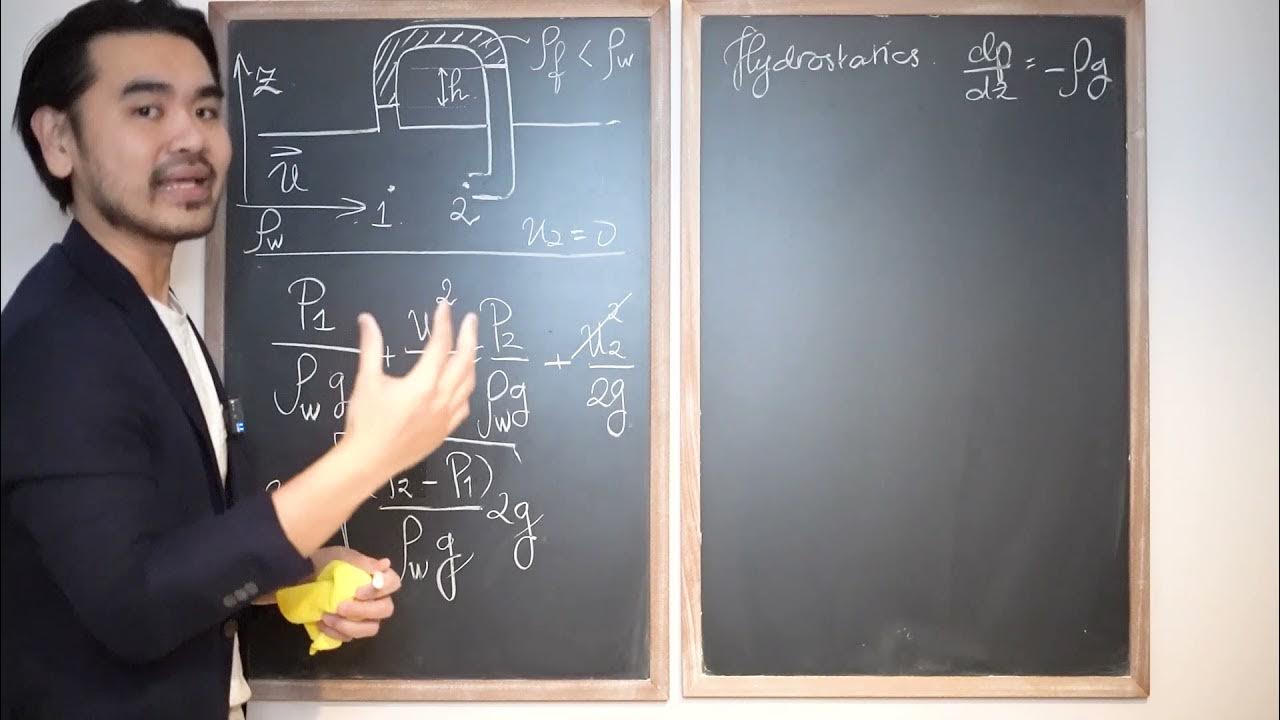Fluid Dynamics VII: The Venturi Effect
Summary
TLDRIn this video, Chris explores the Venturi effect, a special case of Bernoulli's principle, explaining how constricted tubes affect flow and pressure. As the tube narrows, velocity increases while pressure decreases. The flow and pressure are then adjusted by manipulating the tube's angle, particularly when it opens at less than 15°. The video also highlights air entrainment, where atmospheric air is sucked in due to the pressure difference. Chris demonstrates how this effect is applied in devices like Venturi masks and nebulizers, enabling precise control over airflow and air mixing in medical treatments.
Takeaways
- 😀 The script discusses the Venturi effect, which is a special case of the Bernoulli principle in fluid dynamics.
- 😀 A Venturi tube is used to demonstrate how fluid velocity increases as it passes through a constriction, while pressure decreases.
- 😀 When the tube is reopened at an angle of less than 15°, the flow decreases but pressure increases again.
- 😀 The concept of P1, P2, and P3 is introduced, where P1 is high pressure, P2 is low pressure, and P3 increases after the constriction.
- 😀 The pressure drop in the constriction creates an environment where atmospheric pressure causes air to be sucked into the system.
- 😀 This air entrainment is crucial in applications like Venturi masks and nebulizers, which utilize the Venturi effect to mix air and oxygen.
- 😀 The Venturi effect helps increase overall flow by mixing atmospheric air with the primary flow, enhancing air concentration control.
- 😀 The Bernoulli principle is applied here to explain the relationship between pressure, velocity, and flow in the context of a constricted tube.
- 😀 The special case in the script refers to how flow and pressure behave when the angle of the tube is less than 15°, leading to specific changes in the system.
- 😀 The Venturi effect is essential in various medical applications, especially in devices that require precise air and oxygen flow, like nebulizers and air entrainment masks.
Q & A
What is the Venturi effect?
-The Venturi effect is a specific case of the Bernoulli principle, where the velocity of a fluid increases as it passes through a constriction, and the pressure decreases.
How does the flow behave in the Venturi effect?
-In the Venturi effect, as the fluid enters a constricted area, its velocity increases, but its pressure decreases. When the tube opens up again, the flow decreases, and the pressure increases.
What happens to the pressure as the fluid moves through a constriction?
-As the fluid moves through a constriction, the pressure decreases due to the increase in velocity, which is a direct application of Bernoulli's principle.
What role does the angle of opening play in the Venturi effect?
-The angle of opening (less than 15°) plays a key role in controlling the flow and pressure. If the tube opens at a shallow angle, the flow decreases, and the pressure increases again.
What is the significance of placing a hole at the constriction in the Venturi effect?
-Placing a hole at the constriction allows for air entrainment, where the higher atmospheric pressure forces air into the tube, increasing the overall flow of air or gas.
How does the Venturi effect relate to medical devices like nebulizers?
-In medical devices like nebulizers and Venturi masks, the Venturi effect is used to entrain air into the system, allowing for the mixing of oxygen with air at different concentrations.
What does the decrease in pressure lead to in the context of the Venturi effect?
-The decrease in pressure through the constriction leads to the entrainment of air from the surrounding atmosphere, which increases the overall flow of air or gas.
Why is it important to manipulate the Venturi effect in healthcare devices?
-Manipulating the Venturi effect in healthcare devices allows for precise control over the flow of air and oxygen, enabling the delivery of different oxygen concentrations to patients.
What does the term 'Bernoulli principle' refer to in fluid dynamics?
-The Bernoulli principle refers to the concept that in a flowing fluid, an increase in the speed of the fluid results in a decrease in its pressure or potential energy.
How does the Venturi effect help in achieving higher flow rates in medical applications?
-The Venturi effect helps achieve higher flow rates by entraining air, which increases the overall flow while maintaining control over the pressure and oxygen concentration.
Outlines

This section is available to paid users only. Please upgrade to access this part.
Upgrade NowMindmap

This section is available to paid users only. Please upgrade to access this part.
Upgrade NowKeywords

This section is available to paid users only. Please upgrade to access this part.
Upgrade NowHighlights

This section is available to paid users only. Please upgrade to access this part.
Upgrade NowTranscripts

This section is available to paid users only. Please upgrade to access this part.
Upgrade Now5.0 / 5 (0 votes)





